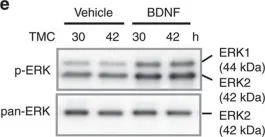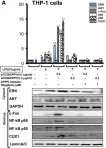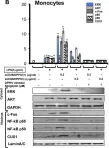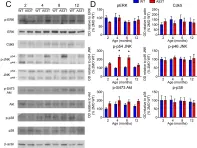Ligation of the B cell antigen receptor (BCR) initiates humoral immunity. However, BCR signaling without appropriate co-stimulation commits B cells to death rather than to differentiation into immune effector cells. How BCR activation depletes potentially autoreactive B cells while simultaneously primes for receiving rescue and differentiation signals from cognate T lymphocytes remains unknown. Here, we use a mass spectrometry-based proteomic approach to identify cytosolic/nuclear shuttling elements and uncover transcription factor EB (TFEB) as a central BCR-controlled rheostat that drives activation-induced apoptosis, and concurrently promotes the reception of co-stimulatory rescue signals by supporting B cell migration and antigen presentation. CD40 co-stimulation prevents TFEB-driven cell death, while enhancing and prolonging TFEB's nuclear residency, which hallmarks antigenic experience also of memory B cells. In mice, TFEB shapes the transcriptional landscape of germinal center B cells. Within the germinal center, TFEB facilitates the dark zone entry of light-zone-residing centrocytes through regulation of chemokine receptors and, by balancing the expression of Bcl-2/BH3-only family members, integrates antigen-induced apoptosis with T cell-provided CD40 survival signals. Thus, TFEB reprograms antigen-primed germinal center B cells for cell fate decisions.
© 2024. The Author(s).
Product Citations: 31
In Nature Communications on 14 August 2024 by Münchhalfen, M., Goerg, R., et al.
-
WB
-
Homo sapiens (Human)
-
Immunology and Microbiology
In Cell Death and Differentiation on 1 July 2024 by Lai, W. Y., Chuang, T. P., et al.
Solute Carrier Family 3, Member 2 (SLC3A2 or 4F2hc) is a multifunctional glycoprotein that mediates integrin-dependent signaling, acts as a trafficking chaperone for amino acid transporters, and is involved in polyamine transportation. We identified SLC3A2 as a potential Anaplastic Lymphoma Kinase (ALK) interacting partner in a BioID-proximity labeling screen in neuroblastoma (NB) cells. In this work we show that endogenous SLC3A2 and ALK interact in NB cells and that this SLC3A2:ALK interaction was abrogated upon treatment with the ALK inhibitor lorlatinib. We show here that loss of ALK activity leads to decreased SLC3A2 expression and reduced SLC3A2 protein stability in a panel of NB cell lines, while stimulation of ALK with ALKAL2 ligand resulted in increased SLC3A2 protein levels. We further identified MARCH11, an E3 ligase, as a regulator of SLC3A2 ubiquitination downstream of ALK. Further, knockdown of SLC3A2 resulted in inhibition of NB cell growth. To investigate the therapeutic potential of SLC3A2 targeting, we performed monotreatment of NB cells with AMXT-1501 (a polyamine transport inhibitor), which showed only moderate effects in NB cells. In contrast, a combination lorlatinib/AMXT-1501 treatment resulted in synergistic inhibition of cell growth in ALK-driven NB cell lines. Taken together, our results identify a novel role for the ALK receptor tyrosine kinase (RTK), working in concert with the MARCH11 E3 ligase, in regulating SLC3A2 protein stability and function in NB cells. The synergistic effect of combined ALK and polyamine transport inhibition shows that ALK/MARCH11/SLC3A2 regulation of amino acid transport is important for oncogenic growth and survival in NB cells.
© 2024. The Author(s).
-
Cancer Research
-
Cell Biology
Pre-Adolescent Diet Normalization Restores Cognitive Function in Young Mice.
In Journal of Clinical Medicine on 24 May 2023 by Sun, W., Okihara, H., et al.
Mastication is a fundamental function critical for human health. Controlled by the central nervous system (CNS), it influences CNS development and function. A poor masticatory performance causes cognitive dysfunction in both older adults and children. Improving mastication may prevent cognitive decline. However, no study has determined the period of masticatory dysfunction that impairs children's later acquisition of cognitive function. Herein, we developed an animal model wherein a soft diet was switched to a normal diet at early and late time points in young mice. We aimed to investigate the impact of restored mastication on learning and memory function. Behavioral studies were conducted to evaluate learning and memory. Micro-CT was used to evaluate orofacial structural differences, while histological and biochemical approaches were employed to assess differences in the hippocampal morphology and function. Correction to a hard-textured diet before adolescence restored mastication and cognitive function through the stimulation of neurogenesis, extracellular signal-regulated kinases, the cyclic adenosine monophosphate-response element-binding protein pathway, and the brain-derived neurotrophic factor, tyrosine receptor B. In contrast, post-adolescent diet normalization failed to rescue full mastication and led to impaired cognitive function, neuronal loss, and decreased hippocampal neurogenesis. These findings revealed a functional linkage between the masticatory and cognitive function in mice during the juvenile to adolescent period, highlighting the need for adequate food texture and early intervention for mastication-related cognitive impairment in children.
-
WB
-
Mus musculus (House mouse)
-
Neuroscience
In Lung Cancer (Amsterdam, Netherlands) on 1 September 2022 by Bokhari, A. A., Lai, W. Y., et al.
Echinoderm microtubule-associated protein-like 4 (EML4)-Anaplastic Lymphoma Kinase (ALK) rearrangements occur in 3% to 7% of lung adenocarcinomas and are targets for treatment with tyrosine kinase inhibitors (TKIs). Here we have developed three novel EML4-ALK-positive patient-derived Non-Small-Cell-Lung-Cancer (NSCLC) cancer cell lines, CUTO8 (variant 1), CUTO9 (variant 1) and CUTO29 (variant 3) and included a fourth ALK-positive cell line YU1077 (variant 3) to study ALK-positive signaling and responses. Variants 1 and 3 are the most common EML4-ALK variants expressed in ALK-positive NSCLC, and currently cell lines representing these EML4-ALK variants are limited.
Resazurin assay was performed to evaluate cell viability. Protein levels were determined using western blotting. RNA sequencing was performed in all four cell lines to identify differentially expressed genes. Whole-genome sequencing was performed to determine the presence of EML4-ALK fusion and ALK tyrosine kinase inhibitor resistance mutations.
In this study, we have confirmed expression of the corresponding ALK fusion protein and assessed their sensitivity to a range of ALK tyrosine kinase inhibitors. These patient derived cell lines exhibit differential sensitivity to lorlatinib, brigatinib and alectinib, with EML4-ALK variant 3 containing cell lines exhibiting increased sensitivity to lorlatinib and brigatinib as compared to alectinib. These cell lines were further characterized by whole genome sequencing and RNA-seq analysis that identified the ribonucleotide reductase regulatory subunit 2 (RRM2) as a downstream and potential therapeutic target in ALK-positive NSCLC.
We provide a characterization of four novel EML4-ALK-positive NSCLC cell lines, highlighting genomic heterogeneity and differential responses to ALK TKI treatment. The RNA-Seq characterization of ALK-positive NSCLC CUTO8, CUTO9, CUTO29 and YU1077 cell lines reported here, has been compiled in an interactive ShinyApp resource for public data exploration (https://ccgg.ugent.be/shiny/nsclc_rrm2_2022/).
Copyright © 2022 The Author(s). Published by Elsevier B.V. All rights reserved.
-
Homo sapiens (Human)
-
Cancer Research
In Obesity (Silver Spring, Md.) on 1 December 2020 by Davis, J. A., Paul, J. R., et al.
This study aimed to investigate both the long-term and short-term impacts of high-fat diets (HFD) or high-sucrose diets (HSD) on the normal diurnal pattern of cognitive function, protein expression, and the molecular clock in mice.
This study used both 6-month and 4-week feeding strategies by providing male C57BL/6J mice access to either a standard chow, HFD, or HSD. Spatial working memory and synaptic plasticity were assessed both day and night, and hippocampal tissue was measured for changes in NMDA and AMPA receptor subunits (GluN2B, GluA1), as well as molecular clock gene expression.
HFD and HSD both disrupted normal day/night fluctuations in spatial working memory and synaptic plasticity. Mice fed HFD altered their food intake to consume more calories during the day. Both diets disrupted normal hippocampal clock gene expression, and HFD reduced GluN2B levels in hippocampal tissue.
Taken together, these results suggest that both HFD and HSD induce a loss of day/night performance in spatial working memory and synaptic plasticity as well as trigger a cascade of changes that include disruption to the hippocampal molecular clock.
© 2020 The Obesity Society.
-
WB
-
Mus musculus (House mouse)
-
Neuroscience
In J Clin Med on 24 May 2023 by Sun, W., Okihara, H., et al.
Fig.6.C

-
WB
-
Collected and cropped from J Clin Med by CiteAb, provided under a CC-BY license
Image 1 of 6
In Front Oncol on 25 July 2019 by Alam, M. W., Borenäs, M., et al.
Fig.1.A

-
WB
-
Collected and cropped from Front Oncol by CiteAb, provided under a CC-BY license
Image 1 of 6
In Nat Commun on 30 September 2016 by Shimizu, K., Kobayashi, Y., et al.
Fig.5.E

-
WB
-
Collected and cropped from Nat Commun by CiteAb, provided under a CC-BY license
Image 1 of 6
In PLoS One on 28 June 2013 by Ikeda, T., Kumagai, E., et al.
Fig.3.A

-
WB
-
Collected and cropped from PLoS One by CiteAb, provided under a CC-BY license
Image 1 of 6
In PLoS One on 28 June 2013 by Ikeda, T., Kumagai, E., et al.
Fig.3.B

-
WB
-
Collected and cropped from PLoS One by CiteAb, provided under a CC-BY license
Image 1 of 6
In PLoS One on 6 April 2013 by Oaks, A. W., Frankfurt, M., et al.
Fig.5.C

-
WB
-
Mus musculus (House mouse)
Collected and cropped from PLoS One by CiteAb, provided under a CC-BY license
Image 1 of 6





